The education system which was evolved first in ancient India is known as the Vedic system of education. In other words, the ancient system of education was based on the Vedas and therefore it was given the name of Vedic Educational System. Vedas occupy a very important place in Indian life. The basis of Indian culture lies in the Vedas which are four in number – Rigveda, Samveda, Yajurveda, and Atharvaveda. Some scholars have subdivided Vedic Educational period into Rig
Veda period, Brahmani period, Upanishada period, Sutra (Hymn) period, Smriti period etc but all these period, due to predominance of the Vedas, there was no change in the aims and ideals of educations. That is why, the education of these periods, is studied under the Vedic period.
The education system of Vedic period has unique characteristics and qualities which were not found in the ancient education system of any other country of the world.
The education system that prevailed during the Vedic times had some unique characteristics. Education was confined to the upper castes, and to those who were BRAHMACHARIS. In Indian tradition, a person’s life cycle is divided into four stages of which BRAHMACHARI is the second phase. There were of two types of BRAHMACHARIS they were: UPAKURVANA BRAHMACHARI who remains a student for a limited time period after which he marries and becomes a householder and NAISHTHIKA BRAHMACHARI who remains a student and celibate throughout a life dedicated to the pursuit of learning.
This is the time set aside for learning and acquiring skills. During the Vedic period, most of the upper castes, which were either Brahmins or Kshatriyas had their education in a unique system called GURUKULAM. Students had their education by living with their preceptors in forests far removed from cities, towns or villages. The life of students who were called SHISYAS was very rigorous and demanding. Those who failed to live up to these high standards would simply fall by the wayside. There were legendary acharyas like Sanandeepani and Dronacharya who taught epic heroes like Krishna and Arjuna martial skills, but what makes the Vedic period unique is the existence of sages like Gautama and Jaimini who were the founder of different schools of Indian philosophy like Nyaya and Purva Mimamsa. This was a period of intense intellectual activity and speculation, which we hardly find even now.
SALIENT FEATURES OF VEDIC EDUCATION IN ANCIENT INDIA
1. Infusion of Spiritual & Religious Values:
The primary aim of ancient education was instilling into the minds, of pupils a spirit of being pious and religious for the glory of God and good of man. The pursuit of knowledge was a pursuit of religious values. Education without religions instructions was no education at all.
2. Character Formation and Personality Development:
In no period of the History of India, was so much stress laid on character building as in the Vedic period. Wisdom consisted of the practice of moral values. Moral Excellence could come only through practising Moral values.
3.Knowledge:
Education is knowledge. It is mans third eye. This aphorism means that knowledge opens mans inner eye, flooding him with spiritual and divine light, which forms the provision for man‘s journey through life.
4. Aims of Education:
The ultimate aim of education in ancient Indian was not knowledge as preparation for life in this world or for life beyond, but for complete realization of self for liberation of the soul from the chains of life both present and future.

